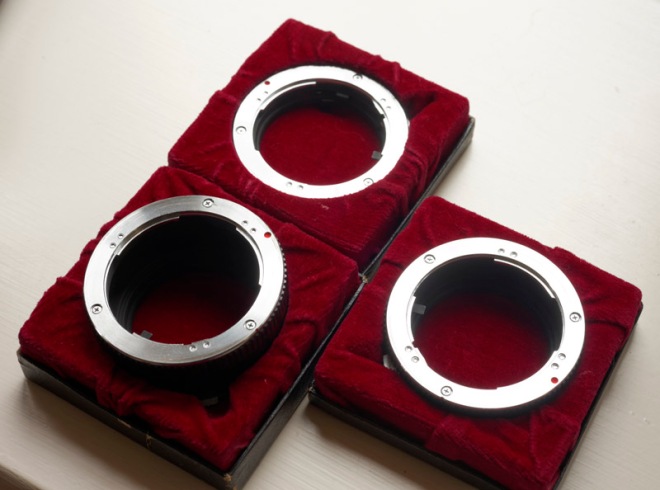Hanging around the 50mm focal length in these tests (I seem to have a few 50mm lenses), it’s time for a 50mm macro. I tested this lovely old lens on a Canon 60D (here) some time ago and found it to be pretty good on a ‘crop frame’ sensor. The predictable question is – what’s it like on full frame? All shots in aperture priority, ‘evaluative’ metering mode, shot in RAW and converted in DXO Optics 9.

At minimal focus distance – this lens gets you quite close!
This is an old OM series lens from the film days – an adaptor will be needed to fit it to a modern DSLR.

Here it is at infinity focus, compact, light and generally rather satisfying to use.
The lens is an ‘old school’ quality all metal affair with a smooth focussing rack going from infinity to 23 cm in almost a full turn. Obviously there’s no autofocus or image stabilisation – these features weren’t invented when this was made. Note how much of that turn is past 1 metre in the shot above – fast, fluid focussing makes this lens a pleasure to use.

At closest focus distance and fully extended.
To give you a rough idea the closest focus distance is around three inches/seven cm in front of the lens – it can go closer but you’ll have to read on to find out how! At this closest distance, reproduction is around 1/2 life-size (i.e. the subject is 1/2 as big on the sensor as it is in real life).
Onto a few samples then – and before we start, shooting these was some of the best photographic fun I’ve had in a while. Looking for shots at this scale is very absorbing and time-consuming. If you’re going shooting with any companions make sure they’re patient and understanding!

Taken at f3.5 using the ‘gently move the camera back and forth until the subject is in focus’ technique. Sharp enough I’d say.
Focussing on the 5D’s default screen is quite easy – depth of field is very shallow at these distances at f3.5, and it’s pretty obvious when things are in focus. The major problem is camera shake – keep the shutter above 1/250th with a higher ISO if necessary.

A classic subject for a macro lens – taken on an overcast day at f3.5. The bokeh is nicely behaved and unobtrusive.

Shooting hand-held at arm’s length on the LCD is a bit tricky (these were seven feet off the ground on the tree) but it sometimes comes off.

The colours are natural, the only oddity being that an ‘auto levels’ in Photoshop produces a green or blue tinge. This isn’t unusual when shooting with older lenses.
Good so far, especially given that these are all hand-held. To get a bit closer let’s dig out the old OM extension tubes…

These all metal Olympus extension tubes were bought second-hand when I was a student some 30 years ago, and have paid for themselves several times over. Amazingly they come in three velvet lined boxes – a cut above modern kit packaging! I always feel rather spoilt when they’re used, and it’s quite nostalgia trip.
The extension tubes are 7mm, 14mm and 25mm deep and extend the distance between the lens and subject allowing for higher magnification. With the 25mm tube the reproduction ratio is 1:1 – i.e. the subject image is as large on the sensor as it is in real life. Using the front half of the ‘Kod Pus‘ as a subject – an old folding Kodak rollfilm camera – this is as close as the lens gets without any extension tubes.

Without extension tubes this is as close as you can get. The front lens is about 14cm / 1/2 an inch in diameter.

With the 25mm extension ring (1:1).

With all three rings stacked (46mm extension and quite a bit greater than 1:1!).
Using extension tubes really tests the resolution of a lens as only a portion of the image circle strikes the sensor – the greater the extension the smaller the segment used. Still, these aren’t too bad at all – even if those markings are rather confusing – Marine?

Back outdoors again – even at f3.5 at close distances the shallow depth of field can look quite ‘expensive’.
All in all then a sensible, well-behaved lens which shows good to excellent results even when hand-held. If you can live without AF and IS, save some money- they’re quite common on the second-hand market at around £100, but the extension tubes are relatively rare and I’ve no idea how much they go for – glad I held on to mine! There is an f2 version, but that’s rare and pretty expensive.
Warning – if you do get this (or any macro lens) be ready for slow progress on photo days out…
The tech specs for this (and lots of other old Zuikos) are here.
If you’re interested in using other MF lenses on your DSLR have a look at the other reviews on the film, camera and lens review index tab.
Thanks for looking – hope you find this useful.
